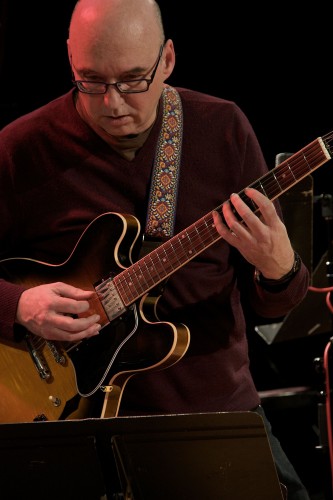Jazz musicians earn part of what is laughingly referred to as their “living” by doing what they call “jobbing gigs,” on which they provide all-purpose music for various functions. Guido Basso calls what is generally required on these gigs “jolly jazz”: a variety of familiar songs – standards, bossa novas, maybe even the odd jazz tune – well-played at tempos which are danceable, or at least listenable. Not that anyone at these dos actually listens – the music is generally intended as background to deafening chatter – but just in case. The time-honoured m.o. of these gigs is “faking” – that is, playing umpteen songs without using any written music. Even when all of the musicians involved know a lot of tunes, there is a certain amount of repertorial Russian roulette involved. Nobody knows every song – well, Reg Schwager maybe – but even if you know the given song, it may not come to you until after it’s over and it’s too late. Generally though, faking works and it cuts down on schlepping music and music stands.
But a couple of bullets are added to the faking Russian roulette pistol every December, when seasonal music is thrown into the jobbing mix. Both the risks and stakes suddenly go up as musicians are naturally expected to play Christmas standards – familiar and dear to all – but which they haven’t played for a whole year. (By “Christmas standards” I mean more modern seasonal songs with some kind of jazz element such as Walking in a Winter Wonderland or White Christmas, as opposed to traditional carols which are generally performed by roving choirs or brass ensembles.)
On the face of it, faking seasonal standards doesn’t seem like such a challenge, because we all know how these chestnuts (no pun intended) go, right? But you’d be surprised. Not all Christmas standards are as simple as they seem, some are quite complicated and after a year in mothballs they can prove a little elusive. Even the easier ones – such as Santa Claus Is Coming to Town or Let It Snow – present challenges because they don’t behave like other songs. Often their middle sections – or bridges – go into the key of the dominant, which very few other songs do. And because the bridges often occur only a quarter of the time, they’re harder to remember. I’ve been on many a seasonal gig where a faked Christmas tune is going along swimmingly until the middle is approaching and everyone gets a panicky look on their face which says, “Where the hell does the bridge go?” It’s ironic, but the seeming simplicity of the easier seasonal songs confound jazz musicians who spend the rest of the year negotiating the fiendish complexities of songs such as Lush Life or Round Midnight without a hitch, and maybe that’s part of the problem. Being accustomed to complex harmony, jazz musicians playing simple Christmas tunes are a bit like cryptic crossword experts who have difficulty solving regular crosswords.
There are two harmonically complex seasonal standards though: The Christmas Song, and Have Yourself a Merry Little Christmas, each of them a must-play. Both are ballads and their slow tempos exacerbate the chord change clashes which lurk around every corner. Taken in the key of E-flat, The Christmas Song has two quick and tricky modulations in its first eight bars alone: to the key of G-Major then immediately to G-flat Major. These key changes come as something of a surprise if you haven’t played it in 12 months, but even if you do remember them there are all sorts of chord-change options to trip over before the modulations. Altogether this makes faking Mel Torme’s classic for the first time in a year a sweaty experience.
Have Yourself a Merry Little Christmas may be the best of the lot and is somewhat easier, but still has its scary moments. It’s smooth sailing up until the beginning of the bridge, which can start on one of two chords fraught with conflict for a bassist and a pianist. Again in E-flat, the first chord of the bridge could be A-flat Major 7, or the “hipper” option – an A Minor 7 flat-five chord which has all the same notes save for the all-important root. Notice the roots are a semitone apart, and there’s the rub. As the bridge arrives, a bassist has to make a split-second decision about which root to play, with a 50/50 chance of being dead wrong and sounding like an idiot. If he or she chooses the A and the pianist plays the A-flat chord it sounds awful and vice versa; it’s a game of chord-change chicken. If I had a dollar for every time I zigged when I should have zagged in this situation, I’d be a rich man. The smart solution would be for the pianist to omit the root altogether and leave the choice up to the bassist. But no, that would be too easy, and not many pianists think this way. This may seem like a small detail and it is, but the trouble with these clashes is that they leave you frazzled and jar your concentration, which can lead to further clunkers along the way.
The big problem is that these seasonal faking mishaps occur in a context riddled with expectation, memory and the potential to spoil the seasonal mood. It’s an important time of year and the people at a seasonal gig know all these tunes intimately from years of hearing them on records and in movies, usually in more deluxe versions with strings, choirs, Bing Crosby, etc. Messing up a Christmas tune leaves the band with eggnog on its face and is like messing up a national anthem – everybody hears it right away and sometimes offence is taken. As in, “Who hired these bums and how much are they being paid? They can’t even play White Christmas, for crying out loud!”
 But not all the disasters of seasonal gigs come from faking tunes; some of them have to do with the merrymaking of the audience. Here are a couple of Christmas party stories to illustrate this. About 15 years ago guitarist Ted Quinlan hired saxophonist Mike Murley, drummer Ted Warren and me to play a Christmas party, held on the third floor of The Senator, for a small company. Ted is prized for his musical versatility and his whacky sense of humour, both of which came in handy on this gig. After no time at all it became clear that the people weren’t going to pay any attention to the music, all was din. We were playing God Rest Ye, Merry Gentleman when, thinking of the lyrics, I glanced over at Ted, who had a typically maniacal grin on his face. Somehow I knew this meant that he was going to yell out “Satan!” from the carol’s fifth line and when the time came we both bellowed “Satan!” at the top of our lungs. Nobody noticed except the other two guys in the band, who proceeded to join us with “Satan!” in the next choruses. I still don’t know how we managed to get through the tune with all the laughing, but we had to take a break afterwards from sheer exhaustion.
But not all the disasters of seasonal gigs come from faking tunes; some of them have to do with the merrymaking of the audience. Here are a couple of Christmas party stories to illustrate this. About 15 years ago guitarist Ted Quinlan hired saxophonist Mike Murley, drummer Ted Warren and me to play a Christmas party, held on the third floor of The Senator, for a small company. Ted is prized for his musical versatility and his whacky sense of humour, both of which came in handy on this gig. After no time at all it became clear that the people weren’t going to pay any attention to the music, all was din. We were playing God Rest Ye, Merry Gentleman when, thinking of the lyrics, I glanced over at Ted, who had a typically maniacal grin on his face. Somehow I knew this meant that he was going to yell out “Satan!” from the carol’s fifth line and when the time came we both bellowed “Satan!” at the top of our lungs. Nobody noticed except the other two guys in the band, who proceeded to join us with “Satan!” in the next choruses. I still don’t know how we managed to get through the tune with all the laughing, but we had to take a break afterwards from sheer exhaustion.
A few years later, singer John Alcorn hired guitarist Reg Schwager and me – his regular band – to play a Christmas party for a small law firm, held in a private banquet facility in a downtown restaurant. It was a fairly intimate party with the people close at hand, some of them even listening to the music. All was going well until we came back from our second break and noticed that suddenly everybody was drunk. Particularly a large East Indian gentleman who really had the lamp shade on, like Peter Sellers in The Party, only louder. Alcorn called Route 66 – not a seasonal song, but a good party tune. As he began singing it, the Indian guy bellowed out “Oh goody, it’s Route 67!” and began dancing a ridiculous teetering boogie only he understood. Reg and I both doubled over laughing, but still somehow managed to keep playing. Alcorn didn’t bat an eye though; his face was a mask of composure and he kept singing as if nothing had happened. That, ladies and gentleman, is professionalism.
So these are a couple of examples of musicians getting their own back amid the minefield of Christmas gigs. A few years ago some of us found a new way of having fun with seasonal music: a mashup game in which we combined the names of Christmas carols/songs with jazz tunes and standards to form wacky new titles. “Hark the Herald Angels Sing Sing Sing,” “Joy Spring to the World,” “Sippin’ at Jingle Bells,” “Silent Night in Tunisia,” “What Child Is This Thing Called Love?” and “O Little Rootie Tootie Town of Bethlehem” were among the first of these; later I expanded the game to include readers and wrote a piece about it. If you’re interested, google wallacebass.com and look for the title “Birth of the Yule” (or use the direct link:
wallacebass.com/?p–4462).
I’d like to take this opportunity to wish everyone a joyous and safe holiday season and a Happy New Year. The latter usually comes with resolutions, some of which are easier to stick to than others. A few years back I resolved to stop taking New Year’s Eve gigs, only to discover they’d disappeared. All New Year’s resolutions should be so easy to keep.
Toronto bassist Steve Wallace writes a blog called “Steve Wallace jazz, baseball, life and other ephemera” which can be accessed at wallacebass.com. Aside from the topics mentioned, he sometimes writes about movies and food.



